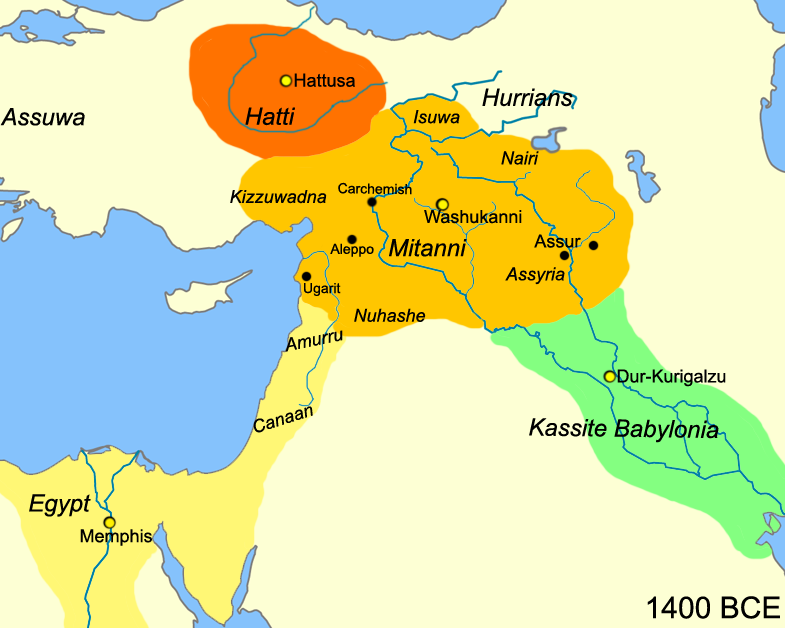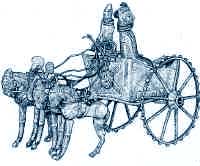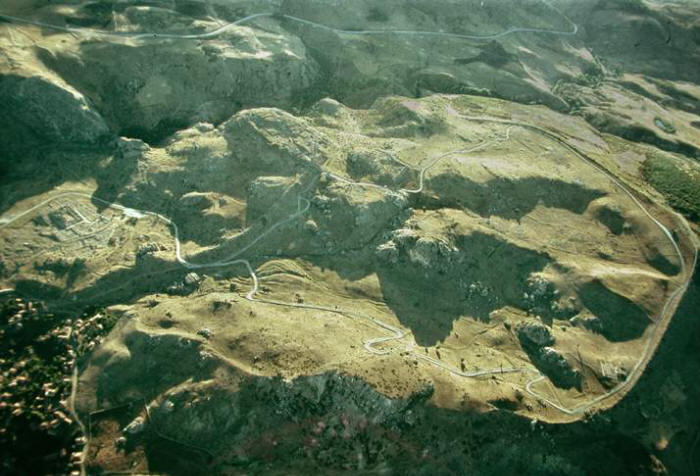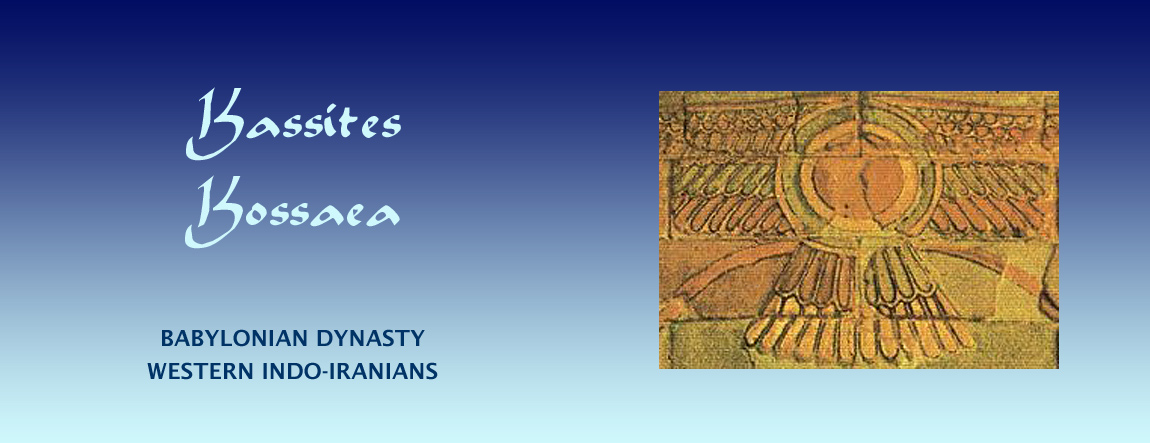
Hittite Treaty
 Suppiluliuma (Hittite) -Shattiwaza (Mitanni) Treaty Excerpts
Suppiluliuma (Hittite) -Shattiwaza (Mitanni) Treaty Excerpts
KBo 1 1
A Obv. 1-16: When My Majesty, Suppiluliuma, Great King, Hero, King of Hatti, Beloved of the Storm God, and Artatama, king of the land of Hurri, made a treaty with one another, at that time, Tushratta, king of the land of Mitanni, called for attention from the Great King, King of Hatti, Hero. And I, Great King, King of Hatti, Hero, turned my attention to Tushratta, king of the land of Mitanni: I plundered the lands of the west bank of the River [Euphrates] and I annexed Mount Lebanon. A second time King Tushratta was presumptuous to me and spoke as follows: “Why are you plundering on the west bank of the Euphrates?” – thus King Tushratta – “If you plunder the lands of the west bank of the Euphrates, then I too will plunder the lands of the west bank of the Euphrates.” King Tushratta desired to bring it under control(?): “If you plunder them, what will I do to them? If a lamb or if a kid of my land is …, I will cross over from the east bank of the Euphrates”. I, Great King, King of Hatti, maintained my pride before him. In the time of the father of the King of Hatti, the land of Isuwa became hostile, so that the troops of Hatti entered the land of Isuwa. In the time of my father, the troops of the city of Kirtalissa, the troops of the city of Arawanna, the land of Zazia, the land of Kalasma, the land of Timana, Mount Haliwa, Mount Karna, the troops of the city of Turmitta, the land of Alha, the land of Hurma, Mount Harana, half of the land of Tegarama, the troops of the city of Tepurziya, the troops of the city of Hazka, and the troops of the city of Armatana became hostile. But My Majesty. Suppiluliuma, Great King, King of Hatti, Hero, Beloved of the Storm God, defeated them. Now the troops, which had escaped from me, had entered the land of Isuwa and all these troops and these lands, which had become hostile in the time of my father, were dwelling beyond the land of Isuwa among the enemy.
A Obv. 17-24: And, I, My Majesty, Suppiluliuma, Great King, King of Hatti, Hero, Beloved of the Storm God, set out against the presumptuousness of King Tushratta. I crossed the Euphrates and went to the land of Isuwa. For the second time, I overpowered the land of Isuwa and for the second time, I made them my subjects. The troops and lands which in the time of my father entered the land of Isuwa: the troops of the city of Kirtalissa, the troops of the city of Arawanna, the land of Zazisa, the land of Kalasma, the land of Timana, Mount Haliwa, Mount Karna, the troops of the city of Turmitta, the land of Alha, the land of Hurma, Mount Harana, half of the land of Tegarama, the troops of the city of Tepurziya, the troops of the city of Hazka, and the troops of the city of Armatana - these troops and those lands I overpowered and returned to Hatti. I freed the lands which I captured; they dwelt in their places. All the people whom I released rejoined their peoples and Hatti incorporated their territories.
A Obv. 25-29: And, I, My Majesty, Suppiluliuma, Great King, King of Hatti, Hero, Beloved of the Storm God, reached the land of Alši and the district of Kutmar and I overpowered them. I gave it as a gift to Antaratli of the land of Alši. I penetrated to the district of Šuta and plundered the district of Šuta. I reached the city of Waššukanni in search of plunder. I brought to Hatti the cattle, sheep and horses of the district of Šuta, along with its possessions and its civilian captives. But King Tushratta fled. He did not come against me for battle.
Obv. 30-37: I crossed the Euphrates again and overpowered the land of Halab and the land of Mukish. Takuwa, king of Niya, came before me for peace terms in the land of Mukish. But behind the back of Takuwa, his brother, Aki-Teshup, brought the land of Niya and the city of Niya to hostility…I, Great King, King of Hatti, overpowered the city of Arahati. I captured Akiya, king of Arahati; Aki-Teshup, brother of Takuwa; and all of their chariot warriors, together with their possessions, and brought them to Hatti. I also brought the city of Qatna, together with its belongings and possessions to Hatti,….
Obv. 38-47: When I went to the land of Nuhašše, I captured all of its territory. Its king Šarrupši alone escaped but I captured his mother...I installed Takipšarri, subject of Šarrupši, in kingship over the city of Ukulzat. I went to the land Apina, but I did not seek to attack the land of Kinza. But its king Šutatarra, together with his son Aitakama and his chariotry, came against me for battle. I drove him off and they entered the city of Abzuya. I invested Abzuya and I captured Šutatarra, together with ....and brought them to Hatti. I went to the land of Apina and Ariwana, king of the land of Apina, and his noblemen,..came against me for battle. I brought all of these, together with their land and their possessions to Hatti. Because of the presumptuousness of King Tushratta, I plundered all of these lands in one year and brought them to Hatti. From Mt Lebanon and from the far bank of the Euphrates I made them my territory.
Obv 48-58: When his son conspired with his subjects, he killed his father , King Tushratta. And with the death of King Tushratta, the Storm-god decided the legal case of Artatama. His son brought the dead Artatama back to life. The entire land of Mitanni went to ruin and the land of Assyria and the land of Alši divided it between them. Until now, I, great King, Hero, King of Hatti, have not crossed to the est bank and have not taken even a blade of straw or a splinter of wood of the land of Mitanni... …
A Rev 14-21: I, Great King, King of Hatti, captured the land of Mitanni. I did not capture them in the time of Prince [Shattiwaza]; I captured them in the time of Tushratta. The Euphrates [is my frontier (?)]. In my rear, I established Mount Lebanon as my frontier. And all of the cities [of the land of Carchemish – the cities of Carchemish], Murmurik, Shipri, Mazuwati and Šurun – these fortified cities [of the land of Carchemish] – I gave [to Piyassili], my son. All the cities which are situated in the land of Ashtata, on the west bank [of the Euphrates] of the land of Mitanni – Ekalte, … , Ahuna and Terqa – these cities belong to the land of Ashtata. Since Prince Piyassili crossed the Euphrates with [Prince] Shattiwaza and penetrated to the city of Irrite, all the cities on the west bank which Piyassili, [my son] holds – these belong to Piyassili. …
A Rev 35-53: the Storm-god, Lord of Heaven and Earth, the Moon-god and the Sun-god, the Moon-god of Harran, heaven and earth, the Storm-god, Lord of the kurinnu of Kahat, the Deity of Herds of Kurta, the Storm-god, Lord of Uhušuman, Ea-šarri, Lord of Wisdom, Anu, Antu, Enlil, Ninlil, the Mitra-gods, the Varuna-gods, Indra, the Nasatya-gods, Lord of Waššukanni, the Storm-god, Lord of the Temple Platform (?) of Irrite, Partahi of Šuta, Nabarbi, Šuruhi, Ištar, Evening Star, Šala, Belet-ekalli, Damkina, Išhara, the mountains and rivers, the deities of heaven and the deities of earth.
Beckman 6B Version
Obv 31-40: ....From the city of Carchemish where we arrived, we sent a messenger to the people of the city of Irrite, but Shuttarna had influenced the Hurrians with the riches of Tushratta and had united them. We sent to them in Irrite and these Hurrians sent back to Piyassili: “Why are you coming? If you are coming for battle, come, but you shall not return to the land of the Great King!” When we had heard the words of the people of Irrite, we – Prince Piyassili and PrinceShattiwaza – crossed the Euphrates and arrived at Irrite ready for battle.
Obv 41-47: And the gods of the Great King, King of Hatti, protected us, and the Hurrians whom Shuttarna had sent as protection to Irrite, as well as the chariotry and the troops of the district of Irrite, gathered in wait for us. We reached Irrite and the troops and chariotry which had sat within the city came out before us. We captured and destroyed all the …. When the people of Irrite…. Them … they assembled. In Irrite and all the districts of Irrite, they came before us for peace. … The people of the city of Harran and the [districts of ] Harran assembled and came to us […. In] Harran we will establish them.
Akk Obv 48-65; Hitt 1-20: [The Assyrian …] sent him to besiege [Washukanni] and gave them a single chariot warrior as leader. [But] when he [came] to the city [of Washukanni, the people of ] Washukanni refused to make peace. But when the infantry and chariotry of [Assyria] besieged Washukanni, Prince Piyassili and I, Prince Shattiwaza, [were] in Irrite. A messenger came to us from Washukanni [and] spoke [as follows]: “The infantry and chariotry of Assyria are coming for battle [against the infantry and chariotry] of Hatti.” Then we marched out [and] their … came to meet [us], saying “ [ …and] in the [presence] of the scribe [of] the gate of the city of […] And the infantry and chariotry of Assyria …. He took away. But when to us …., we went up to [Washukanni. But] the city of Pakarripa … turned. And when [the people of Pakarripa] heard that [Prince] Piyassili and [Prince] Shattiwaza and both the infantry and chariotry of Hatti were going up to Washukanni.
http://www.heritageinstitute.com/zoroastrianism/ranghaya/suppiluliuma_shattiwaza_treaty.htm
Location
 |
| Mitanni Lands. Source: Wikipedia |
At its greatest extent (for a brief period at the height of its dynastic power), Mitanni territory extended to the Mediterranean coast and into northern Assyria / Mesopotamia, it's south-eastern neighbour.
Mitanni's north-western border with the Hattian kingdom of the Hittites was fluid and constantly subject to aggression except when the two rivals concluded a peace treaty - one that invoked the Indo-Iranian pantheon of Mitra, Varuna, Indra and the Nasatyas - but also one that marked the decline of the Mitanni kingdom and a decrease in size. The Mitanni and Hittites were closely related. The Hittites used the Hurrian language extensively in their inscriptions. They also shared in the development of the light chariot whose wheels used spokes (see below).
The Hurrian lands are today a part of Greater Kurdistan.





















